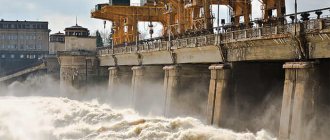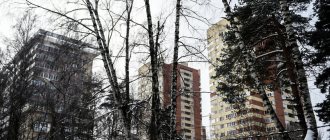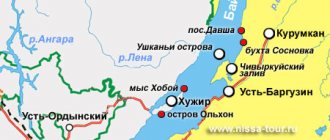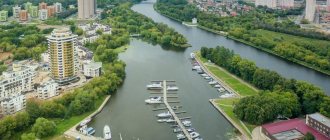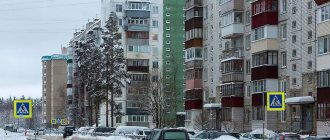Dubna
(until 1958 -
Dubno
), a city of regional subordination in the Moscow region, within the Dubna-Taldom deanery of the Sergiev Posad diocese. Located in the northernmost point of the Moscow region, on the banks of the Volga River, bounded by the Dubnaya and Sestra rivers, the Moscow Canal and the Ivankovsky Reservoir, 125 km from Moscow. The only settlement in the Moscow region located on the Volga. Population 67.9 thousand people (2010)
- On the map: Yandex.Map, Google map
The city of Dubna is known throughout the world as a major scientific center. Scientists from many countries around the world have been fruitfully collaborating here for more than half a century. This is the only Russian settlement immortalized in the Periodic Table of Elements by D.I. Mendeleev: “tannium” is the name of the chemical element 105 discovered by city scientists.
The confluence of the Volga and Dubna rivers was first mentioned in the Novgorod Chronicle in 1134. In 1216, during the war between the Novgorod Republic and the Vladimir-Suzdal Principality, the settlement that existed here was burned by the Novgorodians and was not restored afterwards. Subsequently, the village of Gorodishche and the village of Ratmino arose here.
The village of Ivankovo, located on the left bank of the Volga, was first mentioned in the 18th century. The nearest village of Podberezye has been known since the century, and the village of Yurkino on the Dubna River has been known since the 16th century. The village of Aleksandrovka was founded after the peasant reform in 1861. Here the landowner Prince A.S. Vyazemsky resettled part of the peasants living in the village of Ratmino, giving them land. The village of Kozlaki appeared in the same period. The inhabitants of these villages and the village of Gorodishche were mainly engaged in arable farming, shoemaking and fishing.
In the early 30s of the century, radical changes occurred in the life of the local population, which was associated with the construction of the Moscow Canal and the first Ivankovskaya hydroelectric power station on the Volga. Several surrounding villages were relocated. The village of Ivankovo was among them. Its inhabitants were resettled 4 km downstream of the Volga. And it began to be called Novo-Ivankovo. After the construction of the Volga hydraulic structures was completed in 1937, the workers' settlement of Bolshaya Volga began to grow nearby. Simultaneously with the construction of the Moscow Canal on the left bank of the Volga, the construction of an aviation enterprise was underway, next to which the aircraft manufacturing village of Ivankovo arose.
During the Great Patriotic War, Nazi troops were stopped 20 km from the villages of Ivankovo and Bolshaya Volga. They became frontline territory. Separate units, military courses and a hospital of the 30th Army of the Western Front were located here.
On the right bank of the Volga, near the village of Novo-Ivankovo, in 1947, on the initiative of the head of the Soviet atomic project I.V. Kurchatov began the creation of the world's largest charged particle accelerator in those years - the synchrocyclotron, which was launched in 1949. Dubno in 1954.
.
In 1953, the Institute of Nuclear Problems of the USSR Academy of Sciences was formed on the basis of the Hydrotechnical Laboratory of the USSR Academy of Sciences. After the creation by Western European countries of a nuclear research center (CERN) in the city of Geneva, in contrast to it, on the initiative of the Soviet Union, the Joint Institute for Nuclear Research (JINR) was formed in Dubno in March 1956.
On July 24, 1956, by Decree of the Presidium of the Supreme Soviet of the RSFSR, it was transformed into a city, and later transferred from the Kalinin region to the Moscow region. The village of Bolshaya Volga, the villages of Ratmino, Novo-Ivankovo, Aleksandrovka, Yurkino and Kozloki were annexed to it. In 1958 it became known as the city of Dubna
. The development of the new city was determined by the expansion of JINR.
On the left bank, the village of Ivankovo continued to develop, where, since 1939, the aviation enterprise produced aviation and missile equipment necessary for the defense of the country. In 1958, it was transformed into a city and transferred to the Moscow region, and in December 1960 it was merged with Dubna.
Since 1964, in Dubna, in accordance with the first master plan, the creation of a unified architectural and planning ensemble of the city began. This plan was further developed in a new master plan approved in 1984.
A new impetus to the development of Dubna, especially the oldest district of the city “Big Volga”, was given by the construction, which began in 1969, of the instrumentation plant, which already in 1973 produced its first products - instruments for nuclear power plants of the Soviet Union and CMEA member countries. In 1976, the Federal State Unitary Enterprise Research Institute “Atoll” was located in the same microdistrict, where the development of control systems for water areas of the Soviet Union began.
The city of Dubna is the largest scientific and industrial center in Russia and the Moscow region, with a developed system of education, culture, and healthcare, where high standards of living of the population were ensured.
In 1980, in connection with the opening of the XXII Olympic Games held in Moscow, the Dubna Space Communications Center began operating in Dubna, providing television broadcasts to the regions of Europe and the Atlantic Ocean and stable government telephone communications with the UK, USA, and France. Since that time, Dubna has become a major international teleport.
During the reform period of the 1990s, Dubna managed to maintain the profile of scientific and production activities and lay the foundations for innovative development.
In 1994, Dubna became a university center. The State International University of Nature, Society and Man “Dubna” was opened here.
In December 2001, by Decree of the President of the Russian Federation V.V. Putin, the city was given the status of a science city and a program for its development was approved.
In 2005, by decree of the government of the Russian Federation (dated December 21, 2005 No. 781), it was decided to create a special economic zone of a technology-innovation type in the city of Dubna.
Conferences “Science. Philosophy. Religion"
From 1990 to 1999, annual conferences “Science. Philosophy. Religion", the goal of which was to overcome the disunity between secular and church science and stereotypical ideas about the opposition between science and religion, inherited from the philosophy of the New Age, as well as the formation in the public consciousness of ideological positions that harmoniously combine religious, philosophical and scientific aspects of knowledge. Famous scientists and professors and teachers of higher educational institutions of the capital, and representatives of the clergy, professors and teachers of theological schools took part in the conferences.
After a long break, the tradition of holding annual conferences was resumed in 2007.
Sport
Stele at the entrance to the city
There are five sports complexes and three swimming pools in Dubna.
The city has its own teams for:
- football - FC "Dubna".
- American football - “Vityazi”.
Sections and schools that have trained athletes at the level of Russian and world champions:
- Sambo school of Boris Pivovarov;
- water skiing school of the Nekhaevsky brothers;
- table tennis section at the JINR stadium;
- JINR Weightlifting Section.
In general, as of the beginning of 2009, there were sections and associations in more than 30 sports in the city.
Religion
In a city founded in the era of developed socialism, the plan did not include places of worship. However, in a picturesque place - the spout of the Dubna and Volga rivers, there is the Church of the Praise of the Blessed Virgin Mary, built in 1827.
In the winter of 1993, in the area of the city cemetery of Dubna, a Temple was founded in the name of All Saints who shone in the Russian land.
In the summer of 1995, construction began on the Temple of the Smolensk Icon of the Mother of God in the left bank part of the city of Dubna in the old cemetery.
In the spring of 2000, an initiative group arose in Dubna advocating the construction of the Church of the Nativity of John the Baptist, the construction of which began in August of the same year.
Until 1994, Dubna was part of the Dmitrovsky deanery district of the Moscow regional diocese. In 1994, due to the increase in the number of parishes, the Taldomsky deanery district was established, which includes churches in the city of Dubna and the Taldomsky district. On October 9, 2007, at the diocesan meeting of the Moscow diocese, the Taldom deanery was renamed the Dubna-Taldom deanery with its center in the city of Dubna.
Since April 13, 2022, the city of Dubna has been part of the independent Sergiev Posad diocese as part of the Moscow Metropolis [1].
The city operates a non-state educational institution “Orthodox gymnasium “ODIGITRIA” at the Church of the Smolensk Icon of the Mother of God.”
The Saints
- sschmch. Mikhail Abramov (1885 - 1937), archpriest, rector of the Dubna Pokhvalinsky Church
Temples
- Epiphany, baptismal chapel at the Church of the Nativity of John the Baptist
- All saints who shone in the Russian land
- Daniel of Pereyaslavl, the temple-chapel is assigned to the Panteleimon Church
- Xenia of St. Petersburg (bell-baptismal tower at the Church of the Smolensk Icon of the Mother of God)
- Panteleimon the Healer
- Praises to the Blessed Virgin Mary
- Nativity of John the Baptist
- Smolensk Icon of the Mother of God
Education and science
Coat of Arms (1976)
23 preschool institutions, 12 state and 3 non-state schools. Moscow Regional Industrial and Economic College, Moscow Regional Agrarian and Technological College, Center for Children and Youth Tourism and Excursions.
Universities:
- branch of the Moscow State University of Service (MGUS).
- representation of the International Academy of Assessment and Consulting (IAOC); (It does not work)
- branch of the Moscow State Institute of Radio Engineering, Electronics and Automation (Technical University);
- Research Institute of Nuclear Physics, Moscow State University;
- representative office of the University of the Russian Academy of Education (URAO);
- International University of Nature, Society and Human “Dubna”;
Relief
The city of Dubna is located on the southern tip of the Upper Volga flat lowland (120–150 meters) - the Volga-Dubna lowland, which has a smoothed flat topography, is swampy in places, and on the floodplain terraces of the Volga River. The city's topography was formed over a fairly long period of time, at least more than 1 million years.
The dissection of the territory is very insignificant, the scope of the relief does not exceed 1–3 m from the bottoms of gently sloping depressions, often forming closed and semi-closed hollows and depressions.
Water is like a veil of mystery
Builders of Dubna began to develop the wooded abysses on the island between the Volga, Dubna and Sestra rivers from two independent sites.
The first scientific construction took place in documents as installation “M”. The construction of object “M” - a synchrocyclotron - was headed by Mikhail Grigorievich Meshcheryakov, who returned from the Great Patriotic War.
House of International Meetings (HIM) JINR_Yokki_wiki
“It was early spring with fogs and crisp snow. The railway could not be used: during the war, the rails were removed from the Verbilki - Bolshaya Volga branch, - M. G. Meshcheryakov recalled his first trip to the future Dubna in 1947. — We had to get there in a wartime jeep - it took two hours to get to Dmitrov along a badly broken highway, and then about another four hours we trudged along a road covered with round logs to the Big Volga, from where a caterpillar tractor took about two hours I dragged the jeep to the place where the Archimedes swimming pool is now located. There was damp forest all around, without any gaps.”
From Moscow to this place it was 125 km.
Everything that happened at the M facility was strictly classified. The construction area was protected from prying eyes by a barbed wire fence and was heavily guarded.
The synchrocyclotron was launched on December 14, 1949, on Stalin’s seventieth birthday.
To make what was created in the forests of the Moscow region more incomprehensible to the uninitiated, the new secret synchrocyclotron was called the Hydrotechnical Laboratory. The secret of nuclear research was covered with a curtain of water.
Climate
The studied area belongs to the zone of temperate continental climate, in which air masses of temperate latitudes predominate, transformed from marine air masses of the temperate and arctic zones, to the subzone of the southern taiga.
Due to the great variability of atmospheric circulation, weather variability and sometimes quite abrupt changes are observed. Winters are quite long and relatively cold, summers are moderately warm. In winter, along with persistent frosts, thaws are observed almost every year. In summer, clear and fairly hot weather alternates with rainy and relatively cool weather.
The climatic factors in the Dubna area are greatly influenced by the fact that the city is located between the Ivankovo reservoir and the Volga River; there are extensive swamp systems and forests. This affects not only the temperature regime of the territory, but also humidity, the distribution of precipitation, as well as the wind regime. The abundance of water surfaces is of great importance for changes in relative air humidity and the appearance of fog. The proximity of the reservoir also determines the frequent occurrence of spring and autumn frosts, especially at night.
The average monthly temperature varies greatly throughout the year. The coldest month is January; its average temperature, according to long-term observations, is –10.7o. The highest average monthly temperature is typical for July – +17.8o. The average annual temperature is +3.5o.
On the territory of Dubna, humidity varies widely: relative air humidity reaches its highest values in winter (the monthly average in December and January is 86%), the lowest humidity is observed in May (67%). In terms of precipitation, the city of Dubna belongs to a zone of increased moisture: the average annual precipitation is 783 mm.
The average wind speed for the city of Dubna is approximately 3.3 m/s. The predominant wind direction during the year is southwest with a frequency of 22% throughout the year. These wind directions predominate in the winter; in the summer, along with southwestern winds, northerly winds are typical. Both of these winds bring marine humid air masses and lead to a certain smoothing of the continental climate, to intense winter thaws, to continuous long-term precipitation in the summer, and cause the presence of relatively warm winters and damp, cool summer months.
In winter, due to intensively developing cyclonic activity, almost continuous cloudiness prevails. In summer, as a result of the weakening of cyclonic activity and the intensification of anticyclonic processes, the duration of continuous cloudiness is almost two times less than in winter.
In areas where air masses separate (the so-called fronts), air vortices or cyclones develop, and the city’s territory is covered by them for a long time. The interaction of cyclones determines the nature of the weather in the territory of their development; they are characterized by large clouds, precipitation, strong winds, and low atmospheric pressure. After the passage of the cyclone, partly cloudy and dry weather of the anticyclonic type sets in, which is caused by increased atmospheric pressure.
Employment in Dubna
The permanent population of the Dubna urban district is 75 thousand 144 people. According to preliminary data, the number of people employed in the economy in 2022 is 38 thousand 328 people or 51% of the total population of Dubna. In 2022, according to the registry office, 964 newborns were registered in the city. The mortality rate remained at a low level, and mortality among people of working age decreased.
During 2022, employers in the city district declared a labor demand in the amount of one thousand 111 units to the Dubna Employment Center. At the end of 2022, 180 vacancies remained, of which 74 vacancies were for replacement of blue-collar professions. There are 68 vacancies for quota jobs for employing people with disabilities at the end of 2022. What is required are mainly such professions (specialties) as design engineer, design engineer, process engineer, electrical engineer, printing equipment operator, computer-controlled machine operator, emergency repair mechanic, repairman, turner, stacker-packer, storekeeper, accountant, manager, car driver, teacher, doctor, nurse, physical education instructor, cook, kitchen worker, utility worker and others.
As of December 31, 2018, the number of officially registered unemployed citizens was 173 people, a year ago – 200 people.
In total, 1,040 people applied to the employment service of the city of Dubna in 2022. Of these, 670 are unemployed citizens, 370 are employed.
The most common reasons for dismissal are voluntary dismissal and reduction in the number or staff of employees.
For a number of years, the City District Administration has been participating in co-financing the program “Organization of temporary employment of minor citizens from 14 to 18 years old,” transferring local budget funds to it. In accordance with the Dubna budget for 2022, the annual limit for this program from local budget funds was 355 thousand rubles. At the expense of the local budget, 94 students were employed in educational institutions in Dubna during the summer holidays.
In order to more effectively promote employment, citizens of pre-retirement age, single and large parents raising minor children, children of disabled people take part in the program “Organization of temporary employment of unemployed citizens experiencing difficulties in finding work.” Of the 9 participants who took part in temporary employment, all 9 continued to work on a permanent basis.
61 people took part in the events to organize public works, of which 11 were unemployed. We opened our own business with the assistance of the employment service for 5 unemployed citizens.
Science City
Today, production enterprises operating in Dubna are widely known throughout the world. There are also strictly classified objects.
State Medical Clinical Hospital "Raduga" named after. A. Ya. Bereznyak developed the P-15 Termit anti-ship missile back in 1955, with which the missile era at sea began.
It was manufactured at the Dubninsky Machine-Building Plant. It was these missiles that were to become the basis of Soviet combat missile production for the next half century. The bureau was created in 1951.
Dubninsky Machine-Building Plant named after. N.P. Fedorova initially had a different specificity. In the thirties of the 20th century, the question of creating seaplanes to protect the maritime borders of the USSR became acute.
The first production of such aircraft was established here and continued from 1939 to 1946. Joint work has brought our country to the forefront of developers and manufacturers of cruise technology, having mastered more than 50 types of modern missiles.
In 1945, after the explosion of nuclear bombs in Hiroshima and Nagasaki, humanity entered a new nuclear era. The first proton accelerator was built in Dubna and was launched in 1949. This is how high-energy physics arose in the Soviet Union. The Nuclear Testing Institute, a strictly classified organization, was initially called, for purposes of secrecy, the Hydrotechnical Laboratory. Today, the population of Dubna is proud to live in a city of peaceful atoms; military nuclear development is not carried out here. In 1957, the giant synchrophasotron was launched. This was a victory for Soviet physics. Scientists from all over the country flocked to Dubna. Today, the institute is developing more than fifty applied projects.
The NIKA complex, a collider and heavy ion accelerator, operates in Dubna. Slightly smaller than the Swiss one, it allows scientists to carry out serious research work.
The Space Communications Center in Dubna has been providing government communications and organizing international radio and television broadcasting channels for more than a quarter of a century.
The Daedalus Research and Production Complex produces the most modern and advanced means of border security for all branches of the military. Their customers also include nuclear power plants and oil and gas complex facilities. They were engaged in technical security of the Olympic complex in Sochi.
“I work on the synchrophasotron at work”
The second construction site of the future Dubna was the construction of an even more powerful accelerator - the legendary synchrophasotron. The construction was headed by academician Vladimir Iosifovich Veksler. The synchrophasotron was his brainchild from the idea to the smallest detail.
The more powerful the accelerator, the more expensive it is. Even the most powerful country in the world could no longer bear such costs. It was necessary to combine the efforts of different countries for nuclear research. And so in 1953, the physicists’ village in a deep forest near Moscow was declassified.
Three years later, an international scientific center appeared in the village of physicists - the Joint Institute for Nuclear Research (JINR). And the village was called the city of Dubna.
Exactly one year after the founding of JINR, Academician Weskler’s team launched the synchrophasotron. The mass of colossal magnets of this, at that time the most powerful accelerator in the world, was included in the Guinness Book of Records. The adults rejoiced like children. They drank champagne from cut and paper cups and broken lamp bulbs. The launch of the synchrophasotron brought JINR and Dubna worldwide fame.
And three years later, two parallel threads of the history of the left-bank Ivankovo aircraft manufacturers and the right-bank Dubna physicists were combined into one - the history of the city of Dubna.
